The Elusive and Mysterious Wood Bison
Bison are large, even-toed ungulates of the genus Bison within the family Bovidae, subfamily Bovinae. There are two extant (living) species, the American bison, Bison bison, found in North America, and the European bison or wisent, Bison bonasus, found in Europe and the Caucasus. The American bison and the European bison (wisent) are the largest surviving terrestrial animals in North America and Europe. Bison are nomadic grazers and travel in herds.
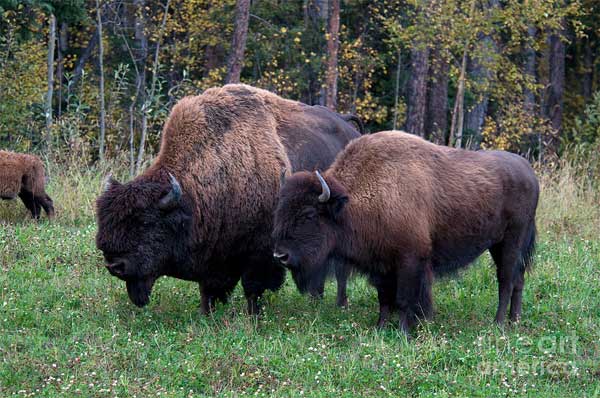
Are wood bison really a subspecies or just a ecotype?
The North American bison has 2 recognized subspecies, the Plains Bison, Bison bison bison Linnaeus 1758, that primarily inhabited the Plains and the Wood Bison, Bison bison athabascae Rhoads 1897 that inhabited the northern boreal regions of Canada and Alaska. The Wood bison is listed as a threatened species in both the Canadian and American Endangered Species List. There have been other subspecies proposed within the B. bison species, but these have not been widely accepted.
In 1915, Shoemaker defined a new eastern Woodland or Wood bison species that existed in the east that was separated and distinct from those of the west. He proposed the name Bison americanus pennsylvanicus or Bison bison pennsylvanicus, Shoemaker 1915 (2). However, Shoemaker's definition was not based on physical remains but only on hearsay and folklore. It was dismissed and considered invalid by the International Commission of Zoological Nomenclature (3).
In 1980, it was proposed that Plains bison be separated into two subspecies, a "southern Plains bison," the subspecies (Bison bison bison Linnaeus 1758) and a "northern Plains bison" (Bison bison monfanae Krumbiegel 1980) (4). This subspecies designation was dismissed on the basis of inadequate sampling and because morphometric analysis failed to distinguish southern from northern Plains bison.
Although the Wood Bison, Bison bison athabascae, has survived the test of time as a subspecies designation, it has not been without controversy. From the very beginning and continuing to this date, the existence of the Wood Bison as a Bison bison subspecies remains divisive (5-7).
There is little doubt that in historic time's bison existed in at least two forms, a dark, large, shy, non-migratory Wood bison in the north, and a smaller, lighter, aggressive, migratory Plains bison in the south. There may also have been some regional differences that native people recognized.
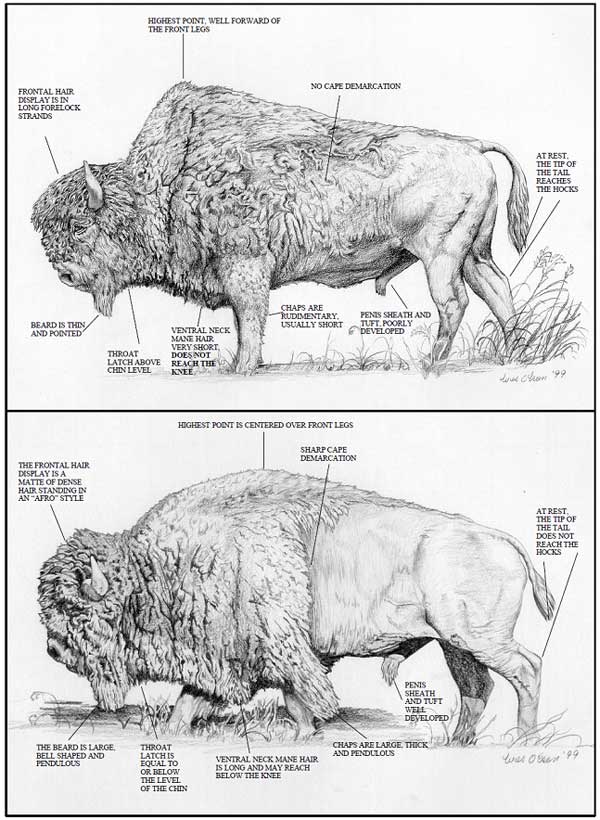
Annotated illustrations showing adult male Wood Bison (top image) and Plains Bison (bottom image). The annotations point out key morphological differences between the two bison. From COSEWIC (1)
In 1876 Allen (8) compiled a major review of the Bison genus and although he considered the contradictory reports about Wood and Plains bison, he chose not to formalize the distinction. Hornaday (9) in 1887 also failed to consider and recognize the Wood and Plains bison as separate species. It was not until 1897 when Rhoads (10) formally recognized Wood bison as the subspecies Bison bison athabascae Rhoads 1897. However, Rhoads relied on second-hand descriptions of one Wood bison specimen, which he did not personally examine. He admitted that the differences between Wood and Plains bison were imprecise and contradictory and that he used J. Macoun's description (10, 11) to describe the proposed Wood bison. The criterion for subspecies distinction between Wood and Plains bison remains obscure and unsettled even now.
So, does the Wood Bison subspecies really exist or is it simply an ecotype, characteristics created by transient environmental influences?
We all know what a Wood Bison looks like and how to tell them apart from the Plains Bison based on external morphology (1, 12), including:
- Difference in the hump. Wood bison have a taller, more pronounced anterior hump with the highest point forward of the front legs, while Plains bison (normally) have a lower hump with the anterior part of the hump lower than the main hump and the highest point centered over the front legs. The hump of the Plains bison is considered rounded, while the Wood bison's is somewhat squared;
- Difference in the chaps. Plains bison have large, thick and pendulous chaps on their front legs while the Wood bison have rudimentary or reduced chaps;
- Difference in frontal hair display. A procumbent, long, thin frontal display hair in Wood bison (long forelock strands), in contrast to the "Afro" hair role of the Plains bison (matte of dense hair);
- Difference in the beard. A thin, short beard, often pointed, of the Wood bison, compared to the full rounded, bell-shaped, and pendulous beard of the Plains bison;
- Difference in the ventral neck mane hair. A short-haired ventral neck mane that is above the knee of the Wood bison, compared to the long-haired neck mane of the Plains bison that may reach below the knee;
- Difference in cape demarcation. In Plains Bison the cap terminates sharply behind the front legs compared to no demarcation in the Wood Bison;
- Difference in tail length. The longer tail of the Wood bison that reaches the hocks while in the Plains bison the tail does not reach the hocks.
- Difference in the throat latch. In Plains bison the throat latch extends equal to or below the chin while in Wood bison the throat latch stops above the chin.
- Difference in the penis sheath and tuft. Wood bison have a poorly developed sheath and tuft while in the Plains bison it is well developed.
In addition to the above, the Wood bison is darker in color than the Plains bison and, compared to the Plains bison, the Wood bison is larger and heavier.
Unfortunately, none of these characteristics are consistent making the distinct separation of Wood and Plains bison difficult. Even the characteristic hump used by many as the hallmark trait of the Wood bison is not a consistent characteristic, as Plains bulls with Wood bison humps are found, and vice versa (1, 7, 13).
Thus, morphometric analysis of phenotypic characteristics has been problematic and the reason many experts of past and present have failed to draw a distinction between the Wood and Plain bison (1, 5-7, 9-14).
In 1970, Roe (11) considered the differences between Wood and Plains bison to have some foundation in reality and were hence valid, whether or not they were of genetic origin or ecotypic, that is, a product of environmental circumstances. But that did little to settle the controversy.
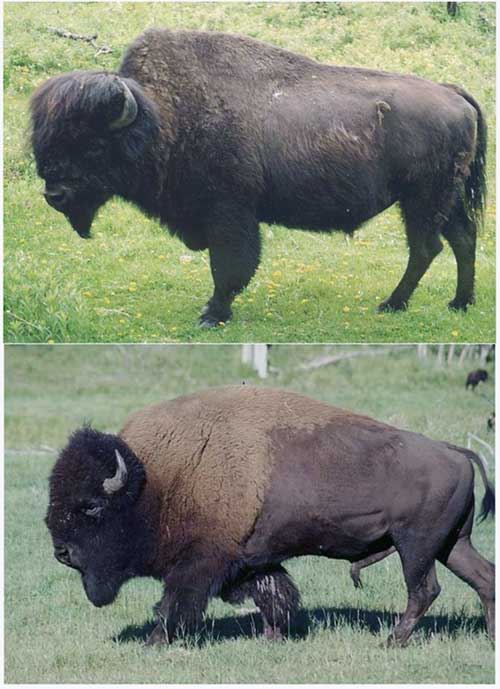
Photographs of mature Wood Bison (top) and Plains Bison (bottom) bulls during summer at Elk Island National Park. Note the morphological and pelage differences as per above illustration. Photographs courtesy of Wes Olson taken from COSEWIC (1).
In 1991 the legitimacy of the Wood bison was again challenged by Geist (6) claiming that the phenotypic differences in size and pelage (fur and hair characteristics) were the result of environmental influences. He noted that Wood bison bulls in captivity in Toronto and Moose Jaw Wild Animal Park (as well as those in Baniff National Park, Calgary Zoo, and other locations) had transformed to the appearance of northern Plains bison as did the Nyarling River Bison from Elk Island National Park held in captive herds with long-haired and dense chaps, long-haired and sharply bordered display coats, "Afro" hair mops, full beards and long ventral manes and some bulls did not have a high anterior hump. Thus, Geist (6) proposed that the Wood bison, Bison bison athabascae, was merely a ecotype (environmentally induced) and that the Wood bison phenotype changes in captivity to a "northern Plains bison" phenotype.
Van Zyll de Jong and coworkers (12) disagreed with Geist contending that the differences in phenotypic characters between Wood and Plains bison are heritable (genetic in origin). Contrary to the claims by Geist, Van Zyll de Jong and coworkers (12) claimed that Wood bison in the Mackenzie Bison Sanctuary and Elk Island National Park, which were both derived from the same source, maintained their Wood-type phenotype despite being in completely different ecosystems – The Mackenzie Bison live in native Wood bison habitat (boreal and subarctic Woodlands, interspersed by marshes) while the Elk Island Bison live in a fenced temperate aspen parkland similar to native Plains bison habitat. The authors claimed that these observations negated the claims by Geist that phenotypic differences between Plains and Wood bison are merely environmentally induced and supported their opinion that the difference between Woods and Plains bison was genetic in origin.
Adding to the controversy is the fact that there are no pure Woods bison in existence and the characteristics associated with Wood bison are likely a mixture of genetic and environmental (ecotype) factors.
In the late 1800's, the Wood bison population inhabiting the area known now as Wood Bison National Park contained only 300-500 individual animals (15). By the 1920's, that population had increased to about 1,500. Between 1925 and 1928, 6,673 Plains bison, (compared to maybe 1,500 Wood bison), were translocated from Buffalo National Park into the Wood Buffalo National Park by the Government of Canada, to avoid mass culling because of overpopulation (5). Despite protests from conservation biologists, this translocation was regarded as a severe tragedy and all remnant Wood bison were hybridized with outnumbering Plains bison (16). With 4 ½ times as many Plains as Wood bison, the pure Wood bison population was extinguished.
In 1989 Agriculture Canada, in concert with federal, provincial and territorial wildlife agencies, considered and proposed the complete extermination of these "worthless hybrid bison" and carriers of brucellosis and bovine tuberculosis in Wood Bison National Park (7). Although supported and upheld by the Bison Disease Task Force, and the Federal Environmental Assessment Review Office (FEARO) (17), the extermination of the bison in the Wood Bison National Park was never performed.
Thus, the bison of Wood Bison National Park and all other known locations are not pure Wood bison but rather Bison bison bison X Bison bison athabascae (Plains x Wood) hybrids (1, 5, 7, 12, 16, 18, 19).
In 1957 the Canadian Wildlife Service identified a small group of bison along the Nyarling River of Wood Bison National Park that was separated from the hybrid bison by 160-320 km and appeared to have escaped hybridization (20). These animals were thought to be last of the pure Wood bison.
To salvage the last of the remaining Wood bison, two herds were salvaged from this isolated stock. In 1963, 6 males and 12 females were relocated to the Mackenzie Bison Sanctuary and, in 1965, 4 males and 17 females were relocated to Elk Island National Park. Both herds are thus based on small samples of the Wood bison gene pool.
However, it soon became apparent that Nyarling River bison were not isolated from the other hybrid bison in Wood Bison National Park and were probably also hybrids (7, 18). They were not separated from the hybrid bison by 160-320 km as originally suggested but were at most separated by 16 km and a well-used trail system between the Nyarling and the Peace rivers insured contact with the other bison populations of Wood Bison National Park. Furthermore, of the 61 bison captured on the Nyarling River, 24 were infected with cattle diseases (tuberculosis and brucellosis) attesting to their contact with the hybrids of Wood Bison National Park (6).
Due to the variability of the Wood bison characteristics, efforts from 1876 to 2016 have consistently failed to adequately define the Wood bison and separate it from the Plains bison. These failures include those prior to the hybridization between the Wood and Plains bison, making post-hybridization characterization near impossible.
If morphometrics (characteristics) cannot conclusively, consistently, and/or reliably separate Plains and Wood bison, what about genetics?
Molecular and genetic studies have also failed to resolve the question of sub-speciation, i.e., the existence of Bison bison athabascae.
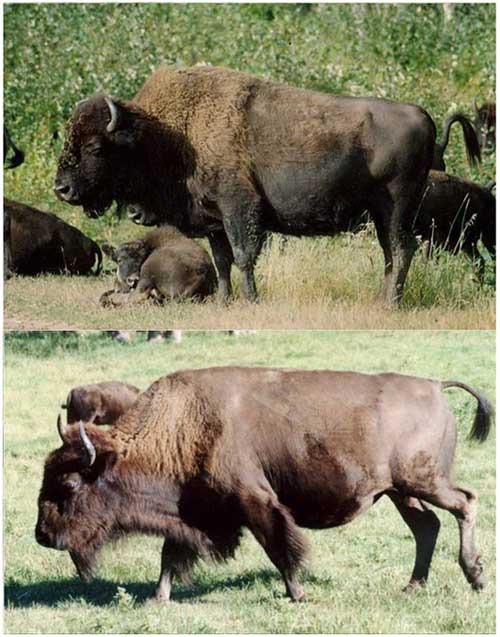
Photographs of mature Wood Bison (top) and Plains Bison (bottom) bulls during summer at Elk Island National Park. Note the morphological and pelage differences as per above illustration. Photographs courtesy of Wes Olson taken from COSEWIC (1)
Although studies of blood characteristics, restriction fragment length polymorphisms, mitochondrial DNA haplotypes, and DNA microsatellites have all found varying degrees of difference between Plains and Wood bison (19, 21-23), all studies have found that the genetic distances and diversity between the sampled populations were generally larger between than within the two bison subspecies. In other words, there are greater differences between Plains bison than there is between Plains and Wood bison. The genetic difference between Wood and Plains bison is also significantly less than that of cattle breeds and subspecies. One cannot assign individual bison to a given subspecies using unique genetic markers on chromosomes (24) or in blood proteins (21), mitochondrial DNA (25), or nuclear DNA (22), particularly if phenotype is considered.
Thus, genetic data, morphometrics, and historical interbreeding of bison do not support recognition of Plains bison and Wood bison as phylogenetically distinct subspecies.
Most recently in 2020, genomic tools were described that can differentiate between Wood and Plains bison based on 17,018 single nucleotide polymorphisms (SNPs) for subspecies composition (26). These genomic tools were developed using sequencing data from 15 Plains bison and 6 Wood bison, and validated against 234 Plains bison and 57 Wood bison. These genomic tools, when available, are said to assist in maintaining the genetic integrity of Plains bison and Wood bison with the conservation goals to maintain pure Wood bison and pure Plains.
But these latest studies suffer from the same deficiency as other genomic studies that bring into question their validity and usefulness.
The Wood bison is a phenotypic type, whether genetic or environmental, and as noted above, these characteristics are extremely variable even within subpopulations of Wood Bison. Since all known Wood Bison have varying degrees of hybridization with Plains bison (5, 19, 27), what were the phenotypic characteristics of the 6 Wood bison used as the reference samples or the 57 Wood bison used for validation? How did they conform to the Wood phenotype? How many of the 9 features were present and what were they? Are Wood bison genetics useful without a direct correlation with specific Wood bison characteristics?
Like so many other studies, this study also relied heavily on the inbred Nyarling River hybrids of Elk Island National Park. As noted above, the bison in Elk Island National Park have their origins in 4 males and 17 females from a single isolated herd and represent a very small sample of the Wood bison gene pool. In addition, the Nyarling bison are not the most "Wood-like" of the Wood bison subpopulations (19).
While the authors recognize that their work is limited by the numbers of reference samples and the need for reliable subspecies labels, relying on data from an inbred herd, no matter how well sampled, describes at best a small range of the natural variation. At the worst, it accepts phenodeviants and genetic variants as normal.
Since the Wood bison is a phenotype characterized by at least 9 features identified above, the failure to correlate or otherwise equate genetic and/or other elements with the Wood phenotype (26) renders the application of genetic testing to identify Wood bison of limited value.
Most studies, the latest included, also rely heavily on the genetics of the Yellowstone National Park bison as the standard of Plains Bison. While relying on bison without evidence of cattle introgression is worthy (28), overreliance on the Yellowstone bison may be inherently flawed, particularly with regard to comparisons to the Wood bison.
Although disputed by Roe (11), according to historical records from the US Wildlife Service (29), the bison of Yellowstone National Park were actually Mountain or Wood bison, specifically referred to as Bison bison athabascae. The indigenous bison of Yellowstone were also hybridized with Plains bison, which diluted the indigenous gene pool to about 40% (29). If Wood/Mountain bison were the indigenous subspecies in Yellowstone, the current hybrid population would be genetically distinct from other Plains bison and be more similar to Wood bison than other Plains bison. Thus, overreliance on Yellowstone bison as the standard for Plains bison may be misguided, particularly with reference to Wood bison.
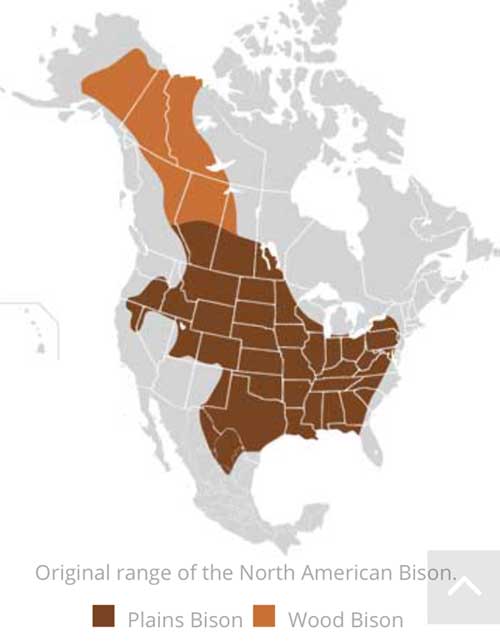
Original habitat of the Woods and Plains bison.
It is generally not appreciated in genomic studies that the similarity or differences in DNA often has little meaning – it is the expression of that DNA that makes the difference. The DNA in your fingers is the same as that in your liver, eyes, lungs, heart, etc., but the DNA is expressed differently to create various tissue phenotypes and functions. Thus, the true difference between the Wood and Plains bison may not be in the raw DNA code itself but rather how that DNA is expressed. For these reasons there exists a need to correlate genomic data with phenotype for DNA studies to have any practical or meaningful value.
It is undisputed that all existing Wood bison originate from a relatively small number of animals, are heavily inbred, and are all hybridized with Plains bison to varying degrees which confuses the current taxonomic status of the Wood bison (5, 19, 27). Further complicating the taxonomic status is the fact that inbreeding results in the fixation of meaningless phenodeviants and genetic variants since small founder populations of bison would rapidly diverge in allele frequencies and impoverish genetically, generating meaningless genetic pseudo-subspecies of little value to conservation.
Although the Wood Bison, Bison bison athabascae, is recognized by the International Commission of Zoological Nomenclature, International Union for Conservation of Nature, and the United States and Canadian Governments, to name just a few, the extant (living) existence of the pure Wood bison, Bison bison athabascae, as a genetically distinct subspecies has likely been lost to genetic admixture with Plains bison (5, 19, 27). As such, the bison subspecies Bison bison athabascae for all practical purposes is extinct.
This is actually good news for the bison industry. As previously noted, the Wood bison, Bison bison athabascae, is listed as a threatened wildlife species in both the Unites States and Canada. Such acts state that "No person shall kill, harm, harass, capture or take an individual of a wildlife species that is listed as an extirpated species, an endangered species or a threatened species" and that "No person shall possess, collect, buy, sell or trade an individual of a wildlife species that is listed as an extirpated species, an endangered species or a threatened species, or any part or derivative of such an individual."
Fortunately, current policy, legislation and international law empowers government to protect and manage the "threatened" Wood bison, specifically Bison bison athabascae, but provides absolutely no protection for hybrids. As such, the designation of Wood bison as hybrids deprives them of all legal protection under the Alberta Wildlife and similar Acts as such protections are granted only to bison specifically designated as Bison bison athabascae, provided, of course, that such can even be identified. A hybrid cannot be Bison bison athabascae.
The Wood bison we know today is a hybrid animal with various degrees of hybridization with Plains bison that exhibit various degrees of "Wood bison" phenotype, probably a composite of environmental and genetic factors. Efforts to suggest Wood bison purity or percentage of "Wood's" are speculative at best.
One might be able to guesstimate the amount of Wood bison based on the number, prevalence, and degree of the 9 phenotypic traits of the Wood bison identified above (7, 12), but because these are all variable, such may not even be an accurate guesstimate.
Despite the continued controversy, the Wood bison is here to stay, even if just a phenotype and not Bison bison athabascae, because Wood bison are still considered different enough from Plains bison to warrant unique status (1, 12).
Ozark Valley Bison Ranch LLC
Fox, AR
Literature Cited
1. Gates CC, Jung TS. 2013. COSEWIC assessment and status report on the plains bison (Bison bison bison) and the wood bison (Bison bison athabascae) in Canada. Committee on the Status of Endangered Wildlife in Canada. Ottawa. xv + 109.
2. Shoemaker HW. 1915. A Pennsylvania Bison Hunt. Middleburg Post Press.
3. Schorger AW. 1944. The Validity of Bison bison pennsylvanicus Journal of Mammalogy 25:313-315.
4. Krumbiegel I, Sehm GG. 1989. The geographic variability of the plains bison. A reconstruction using the earliest European illustrations of both subspecies. Archives of Natural History 16:169-190.
5. Ball MC, Fulton TL, Wilson GA. 2016. Genetic analyses of wild bison in Alberta, Canada: implications for recovery and disease management Journal of Mammalogy 97:1525-1534.
6. Geist V. 1991. Phantom Subspecies: The Wood Bison Bison bison "athabascae" Rhoads 1897 Is Not a Valid Taxon, but an Ecotype. Arctic 44:283-300.
7. Van Zyll de Jong CG. 1986. A systematic study of recent bison with particular consideration of the wood bison. National Museum of Canada, Publications in Natural Sciences No. 6.
8. Allen JA. 1876. The American bison, living and extinct. Memoirs of the Museum of Comparative Zoology 9.
9. Hornaday WT. 1887. The extermination of the American bison with a sketch of its discovery and life history. Washington, DC: Smithsonian Report.
10. Rhoads SN. 1897. Notes on living and extinct species of American bovidae. Proceedings of the Academy of Natural Sciences of Philadelphia 49:483-502.
11. Roe FG. 1970. The North American buffalo, 2nd ed. University of Toronto Press; Toronto.
12. van Zyll de Jong CG, Gates C, Reynolds H, Olson W. 1995. Phenotypic variation in remnant populations of North American bison. Journal of Mammalogy 76:391-405.
13. Geist V, Karsten P. 1977. The wood bison (Bison bison athabascae Rhoads) in relation to hypotheses on the origin of the American bison (Bison bison Linnaeus). Zeitschrift fuer Saugetierkunde 42:119-127.
14. Prusak B, Grzybowski G, Zieba G. 2004. Taxonomic position of Bison bison (Linnaeus 1758) and Bison bonasus (Linnaeus 1758) as determined by means of cytb gene sequence. Animal Science Papers and Reports 22:27-35.
15. Seton ET. 1911. The arctic prairies. N ew York: Charles Scribner's Sons.
16. Van Camp J. 1989. A Surviving Herd of Endangered Wood Bison at Hook Lake, N.W.T.? Arctic 42:314-322.
17. Connelly RG, Fuller W, Mercredi R, Wobeser G, Hubert B. 1990. Northern diseased bison. . Ottawa: Federal Environmetal Assessment Review Office. Report No. 35.
18. Carbyn LN, Huisman D, Street E, Anions D. 1989. An analysis of the decline of bison in Wood Buffalo National Park from 1971 to 1981 and a review of the status to 1989. Canadian Wildlife Service Report. Edmonton, Alberta.
19. Wilson GA, Strobeck C. 1999. Genetic variation within and relatedness among wood and plains bison populations. Genome 42:483-96.
20. Banfield AWF, Novakowski NS. 1960. The survival of the wood bison (Bison bison athabuscue Rhoads) in the Northwest Territories. National Museum of Canada Natural History Paper 8.
21. Peden DG, Kraay GJ. 1979. Comparison of blood characteristics in plains bison, wood bison, and their hybrids. Can J Zool 57:1778-84.
22. Bork AM, Strobeck CM, Yeh FC, Hudson RJ, Salmon RK. 1991. Genetic relationship of wood and plains bison on restriction fragment length polymorphisms. Canadian Journal of Zoology 69:43-48.
23. Polziehn RO, Beech R, Sheraton J, Strobeck C. 1996. Genetic relationships among North American bison populations. Canadian Journal of Zoology 74:738-749.
24. Ying KL, Peden DG. 1977. Chromosomal homology of wood bison and plains bison. Canadian Journaolf Zoology 55:1859-1862.
25. Cronin MA. 1986. Genetic relationships between white-tailed deer,mule deer and other large mammals inferred from mitochondrial DNA analysis Montana State University.
26. Yang T, Miller M, Forgacs D, Derr J, Stothard P. 2020. Development of SNP-Based Genomic Tools for the Canadian Bison Industry: Parentage Verification and Subspecies Composition. Front Genet 11:585999.
27. Cronin MA, MacNeil MD, Vu N, Leesburg V, Blackburn HD, Derr JN. 2013. Genetic variation and differentiation of bison (Bison bison) subspecies and cattle (Bos taurus) breeds and subspecies. J Hered 104:500-9.
28. Halbert ND, Derr JN. 2007. A comprehensive evaluation of cattle introgression into US federal bison herds. J Hered 98:1-12.
29. Meagher M. 1973. The bison of Yellowstone National Park. Washington, D.C.: National Park Service Monograph Series.
